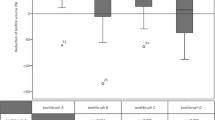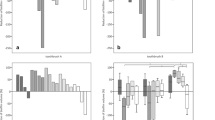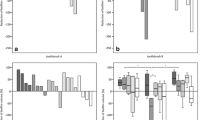Abstract
Objectives
The aim of this study was to evaluate the efficacy of four different powered toothbrushes with side-to-side action for noncontact biofilm removal in vitro.
Materials and methods
A three-species biofilm was formed in vitro on protein-coated titanium disks using a flow chamber combined with a static biofilm growth model. Subsequently, the biofilm-coated substrates were exposed to four different side-to-side toothbrushes (A, B, C, and D) with various brushing times (2, 4, and 6 s) and brushing (bristle-to-disk) distances (0, 2, and 4 mm). The biofilm volumes were measured using volumetric analyses with confocal laser scanning microscope images and Imaris version 7.5.2 software.
Results
The median percentages of biofilm reduction by the analyzed toothbrushes ranged from 9 % to 80 %. The abilities of the tested toothbrushes to remove the in vitro biofilm differed significantly (p < 0.05). Two of the tested toothbrushes (C and D) were capable of significant biofilm reduction by noncontact brushing.
Conclusions
It was possible to reduce a three-species in vitro biofilm by noncontact brushing with two out of four side-to-side toothbrushes.
Clinical relevance
Toothbrushes C and D show in vitro a high efficacy in biofilm removal without bristle contact.




Similar content being viewed by others
References
Socransky SS, Haffajee AD (2000) Dental biofilms: difficult therapeutic targets. Periodontol 28:12–55
Del Pozo JL, Patel R (2007) The challenge of treating biofilm-associated bacterial infections. Clin Pharmacol Ther 82:204–209
Sanz M, van Winkelhoff AJ (2011) Periodontal infections: understanding the complexity—consensus of the Seventh European Workshop on Periodontology. J Clin Periodontol 38(Suppl 11):3–6
Kolenbrander PE, Palmer RJ Jr, Periasamy S, Jakubovics NS (2010) Oral multispecies biofilm development and the key role of cell-cell distance. Nat Rev Microbiol 8:471–480
Walter C, Weiger R (2006) Antibiotics as the only therapy of untreated chronic periodontitis: a critical commentary. J Clin Periodontol 33:938–939, author reply 940–931
Herrera D, Alonso B, Leon R, Roldan S, Sanz M (2008) Antimicrobial therapy in periodontitis: the use of systemic antimicrobials against the subgingival biofilm. J Clin Periodontol 35:45–66
Axelsson P, Nystrom B, Lindhe J (2004) The long-term effect of a plaque control program on tooth mortality, caries and periodontal disease in adults. Results after 30 years of maintenance. J Clin Periodontol 31:749–757
Schmidt JC, Zaugg C, Weiger R, Walter C (2013) Brushing without brushing?—a review of the efficacy of powered toothbrushes in noncontact biofilm removal. Clin Oral Investig 17:687–709
Sharma PK, Gibcus MJ, van der Mei HC, Busscher HJ (2005) Influence of fluid shear and microbubbles on bacterial detachment from a surface. Appl Environ Microbiol 71:3668–3673
Busscher HJ, Jager D, Finger G, Schaefer N, van der Mei HC (2010) Energy transfer, volumetric expansion, and removal of oral biofilms by non-contact brushing. Eur J Oral Sci 118:177–182
Hannig C, Hannig M (2009) The oral cavity—a key system to understand substratum-dependent bioadhesion on solid surfaces in man. Clin Oral Investig 13:123–139
Teles FR, Teles RP, Sachdeo A, Uzel NG, Song XQ, Torresyap G, Singh M, Papas A, Haffajee AD, Socransky SS (2012) Comparison of microbial changes in early redeveloping biofilms on natural teeth and dentures. J Periodontol 83:1139–1148
Palmer RJ Jr, Gordon SM, Cisar JO, Kolenbrander PE (2003) Coaggregation-mediated interactions of streptococci and actinomyces detected in initial human dental plaque. J Bacteriol 185:3400–3409
Paramonova E, Kalmykowa OJ, van der Mei HC, Busscher HJ, Sharma PK (2009) Impact of hydrodynamics on oral biofilm strength. J Dent Res 88:922–926
Lea SC, Khan A, Patanwala HS, Landini G, Walmsley AD (2007) The effects of load and toothpaste on powered toothbrush vibrations. J Dent 35:350–354
Saxer UP, Imfeld T, van Waes H (2010) Medienmitteilung “Hydrodynamik-Schallzahnbürsten”. SSO Taskforce, Bern
Astasov-Frauenhoffer M, Braissant O, Hauser-Gerspach I, Daniels AU, Weiger R, Waltimo T (2012) Isothermal microcalorimetry provides new insights into biofilm variability and dynamics. FEMS Microbiol Lett 337:31–37
Hauser-Gerspach I, Kulik EM, Weiger R, Decker EM, Von Ohle C, Meyer J (2007) Adhesion of Streptococcus sanguinis to dental implant and restorative materials in vitro. Dent Mater J 26:361–366
Weiger R, Decker EM, Krastl G, Brecx M (1999) Deposition and retention of vital and dead Streptococcus sanguinis cells on glass surfaces in a flow-chamber system. Arch Oral Biol 44:621–628
Decker EM, Weiger R, Wiech I, Heide PE, Brecx M (2003) Comparison of antiadhesive and antibacterial effects of antiseptics on Streptococcus sanguinis. Eur J Oral Sci 111:144–148
Decker EM, Weiger R, von Ohle C, Wiech I, Brecx M (2003) Susceptibility of planktonic versus attached Streptococcus sanguinis cells to chlorhexidine. Clin Oral Investig 7:98–102
Decker EM, Maier G, Axmann D, Brecx M, von Ohle C (2008) Effect of xylitol/chlorhexidine versus xylitol or chlorhexidine as single rinses on initial biofilm formation of cariogenic streptococci. Quintessence Int 39:17–22
Cho SB, Nakanishi K, Soga N, Ohtsuki C, Nakamura T, Kitsugi T, Yamamuro T (1995) Defence of apatite formation on silica gel on its structure: effect of heat treatment. J Am Ceram Soc 78:1769
Kazor CE, Mitchell PM, Lee AM, Stokes LN, Loesche WJ, Dewhirst FE, Paster BJ (2003) Diversity of bacterial populations on the tongue dorsa of patients with halitosis and healthy patients. J Clin Microbiol 41:558–563
Kinane DF, Hajishengallis G (2009) Polymicrobial infections, biofilms, and beyond. J Clin Periodontol 36:404–405
Rimondini L, Fare S, Brambilla E, Felloni A, Consonni C, Brossa F, Carrassi A (1997) The effect of surface roughness on early in vivo plaque colonization on titanium. J Periodontol 68:556–562
Dezelic T, Guggenheim B, Schmidlin PR (2009) Multi-species biofilm formation on dental materials and an adhesive patch. Oral Health Prev Dent 7:47–53
Bürgers R, Gerlach T, Hahnel S, Schwarz F, Handel G, Gosau M (2010) In vivo and in vitro biofilm formation on two different titanium implant surfaces. Clin Oral Implants Res 21:156–164
Stepanovic S, Vukovic D, Jezek P, Pavlovic M, Svabic-Vlahovic M (2001) Influence of dynamic conditions on biofilm formation by staphylococci. Eur J Clin Microbiol Infect Dis 20:502–504
Stoodley P, Cargo R, Rupp CJ, Wilson S, Klapper I (2002) Biofilm material properties as related to shear-induced deformation and detachment phenomena. J Ind Microbiol Biotechnol 29:361–367
Verkaik MJ, Busscher HJ, Rustema-Abbing M, Slomp AM, Abbas F, van der Mei HC (2010) Oral biofilm models for mechanical plaque removal. Clin Oral Investig 14:403–409
Adams H, Winston MT, Heersink J, Buckingham-Meyer KA, Costerton JW, Stoodley P (2002) Development of a laboratory model to assess the removal of biofilm from interproximal spaces by powered tooth brushing. Am J Dent 15:12B–17B
Leonhardt A, Adolfsson B, Lekholm U, Wikstrom M, Dahlen G (1993) A longitudinal microbiological study on osseointegrated titanium implants in partially edentulous patients. Clin Oral Implants Res 4:113–120
Heitz-Mayfield LJ, Lang NP (2010) Comparative biology of chronic and aggressive periodontitis vs. peri-implantitis. Periodontol 2000 53:167–181
Romeo E, Ghisolfi M, Murgolo N, Chiapasco M, Lops D, Vogel G (2005) Therapy of peri-implantitis with resective surgery. A 3-year clinical trial on rough screw-shaped oral implants. Part I: clinical outcome. Clin Oral Implants Res 16:9–18
Genco RJ, Ho AW, Grossi SG, Dunford RG, Tedesco LA (1999) Relationship of stress, distress and inadequate coping behaviors to periodontal disease. J Periodontol 70:711–723
Ak G, Sepet E, Pinar A, Aren G, Turan N (2005) Reasons for early loss of primary molars. Oral Health Prev Dent 3:113–117
Borrell LN, Burt BA, Warren RC, Neighbors HW (2006) The role of individual and neighborhood social factors on periodontitis: the third National Health and Nutrition Examination Survey. J Periodontol 77:444–453
Meisel P, Reifenberger J, Haase R, Nauck M, Bandt C, Kocher T (2008) Women are periodontally healthier than men, but why don't they have more teeth than men? Menopause 15:270–275
Quirynen M, De Soete M, van Steenberghe D (2002) Infectious risks for oral implants: a review of the literature. Clin Oral Implants Res 13:1–19
König J, Plagmann HC, Rühling A, Kocher T (2002) Tooth loss and pocket probing depths in compliant periodontally treated patients: a retrospective analysis. J Clin Periodontol 29:1092–1100
Eickholz P, Kaltschmitt J, Berbig J, Reitmeir P, Pretzl B (2008) Tooth loss after active periodontal therapy. 1: patient-related factors for risk, prognosis, and quality of outcome. J Clin Periodontol 35:165–174
Heitz-Mayfield LJ (2008) Peri-implant diseases: diagnosis and risk indicators. J Clin Periodontol 35:292–304
Emling RC, Yankell SL (1997) The application of sonic technology to oral hygiene: the third generation of powered toothbrushes. J Clin Dent 8:1–3
Robinson PG, Damien Walmsley A, Heanue M, Deacon S, Deery C, Glenny AM, Worthington H, Shaw W (2006) Quality of trials in a systematic review of powered toothbrushes: suggestions for future clinical trials. J Periodontol 77:1944–1953
Acknowledgments
We thank Elisabeth Filipuzzi-Jenny (Clinic of Preventive Dentistry and Oral Microbiology, University of Basel) for laboratory assistance; Dr. Oliver Biehlmaier and Dr. Alexa Ferrand (Image Core Facility, Biozentrum, University of Basel) for assistance with microscopic analyses; and Ing. EurEta Sascha Martin (Department of Physics, University of Basel) for the construction of the toothbrush apparatus.
Conflicts of interest
The authors declare that they have no conflicts of interest. This project was supported in part by an unrestricted grant by the Swiss Society of Dentistry (SSO), project number 264-12. The titanium disks were provided by Straumann AG (Basel, Switzerland).
Author information
Authors and Affiliations
Corresponding author
Rights and permissions
About this article
Cite this article
Schmidt, J.C., Astasov-Frauenhoffer, M., Hauser-Gerspach, I. et al. Efficacy of various side-to-side toothbrushes for noncontact biofilm removal. Clin Oral Invest 18, 793–800 (2014). https://doi.org/10.1007/s00784-013-1047-7
Received:
Accepted:
Published:
Issue Date:
DOI: https://doi.org/10.1007/s00784-013-1047-7




